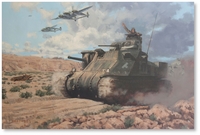
Barbara Ann's Busy Day by Roy Grinnell
 |


|
Choose from:
|
 November 8. 1943, 1/Lt. George Chandler, from Pratt, Kansas, 339FS, 347FG, has safely returned to his base at Munda, New Georgia Island. This day marks the US invasion of Bougainville at Empress Augusta Bay. Flying a P-38-H, George has shot down in a single pass, his second and third victories. Both are Mitsubishi Zero 52s flying from Rabaul and attempting to dive bomb the invasion fleet.
November 8. 1943, 1/Lt. George Chandler, from Pratt, Kansas, 339FS, 347FG, has safely returned to his base at Munda, New Georgia Island. This day marks the US invasion of Bougainville at Empress Augusta Bay. Flying a P-38-H, George has shot down in a single pass, his second and third victories. Both are Mitsubishi Zero 52s flying from Rabaul and attempting to dive bomb the invasion fleet.This lithograph was signed on September 28, 2007 commemorating the 2007 Inductees into the American Combat Hall of Fame, Commemorative Air Force, Midland, Texas.
Signatures:
















